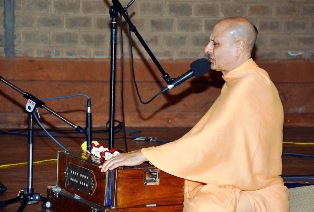 “If our mind is in conflict, not balanced with our body and with the needs of the soul, then there is a fundamental disunity in our life. Only if we have unity within ourselves, we can create unity in the world around us. You can’t give something you don’t have, even if you have all good intentions”
“If our mind is in conflict, not balanced with our body and with the needs of the soul, then there is a fundamental disunity in our life. Only if we have unity within ourselves, we can create unity in the world around us. You can’t give something you don’t have, even if you have all good intentions”
– Radhanath Swami
Leadership can be a daunting task with a wandering mind. It can lead you to weird decisions, insensitive dealings, display of negative emotions, and of course low efficiency.
A model for the mind
 To find a solution, we first look for a model that explains the working of the mind. Models are used extensively in science and everyday life; examples are wooden models of bridges, planes, or ships, Watson and Crick’s metal model of DNA and Phillips’ hydraulic model of the economy. There are also models that are not material models. The Bohr model of the atom, a frictionless pendulum, or isolated populations, for instance, are in the scientist’s mind rather than in the laboratory and they do not have to be physically realized and experimented upon to perform their representational function. Simply put, models are vehicles for learning about the world. Significant parts of scientific investigation are carried out on models rather than on reality itself because by studying a model we can discover features of and ascertain facts about the system the model stands for. So to study the mind, we begin with developing a model for the mind that most accurately represents the characteristics of the mind.
To find a solution, we first look for a model that explains the working of the mind. Models are used extensively in science and everyday life; examples are wooden models of bridges, planes, or ships, Watson and Crick’s metal model of DNA and Phillips’ hydraulic model of the economy. There are also models that are not material models. The Bohr model of the atom, a frictionless pendulum, or isolated populations, for instance, are in the scientist’s mind rather than in the laboratory and they do not have to be physically realized and experimented upon to perform their representational function. Simply put, models are vehicles for learning about the world. Significant parts of scientific investigation are carried out on models rather than on reality itself because by studying a model we can discover features of and ascertain facts about the system the model stands for. So to study the mind, we begin with developing a model for the mind that most accurately represents the characteristics of the mind.
Characteristics of the mind
What are the characteristics of the mind? In Bhagavad Gita, the ancient Vedic classic, featuring the conversation between Arjuna and Krishna, Arjuna eloquently puts forth the ‘mind problem’: “The mind is restless, turbulent, obstinate and very strong, O Krishna, and to subdue it, I think, is more difficult than controlling the wind.”
So the characteristics of the mind are restlessness, turbulence, obstinacy and strength. In case you aren’t convinced, try to closely observe your mind – just for a day – and that will definitely help.
Mind – ‘the desperate searcher’
 Recently I visited Bangalore, and my travel was quite eventful. I boarded the train at noon, and tired as I was, thought of beginning the journey with a good nap. But no sooner did the train start moving than I realize my identity card was missing; and without that I was no better than a ticketless passenger, as per the rules.
Recently I visited Bangalore, and my travel was quite eventful. I boarded the train at noon, and tired as I was, thought of beginning the journey with a good nap. But no sooner did the train start moving than I realize my identity card was missing; and without that I was no better than a ticketless passenger, as per the rules.
I began the desperate search. Fellow passengers looked on in wonder as they now saw me suddenly restless. The bag got emptied with stuffs flying all around, as though hit by a turbulent tornado. All thoughts of a nap which I cherished just a few minutes ago disappeared, as I obstinately went about searching. With every passing moment I seemed to grow in strength; I was powered by my desperation. And when I finally concluded that the card was nowhere to be found, I started searching for the railway ticket checker, in hopes that he would understand my situation and let me travel. I finally found him in another compartment, and fortunately for me, he was a man who believed in sympathy. With his blessings, I peacefully returned to my seat and nodded off.
Later, a deep thought made me conclude that the incident had helped me find the model for the mind. The mind is like ‘a person on a desperate search’. When I was on a desperate search, I too was restless, turbulent, obstinate and strong – just like the mind.
What is the mind searching for?
If the mind is like a person on a desperate search, is the mind also searching for something?
At Harvard, as part of a bigger research, an experiment was conducted on rate of mind wandering. 22 activities were analyzed – taking a shower, brushing teeth, working, exercising, etc. And it was found that people’s mind wandered the least while having sex. The natural conclusion is, the mind is searching for happiness or pleasure, and when it finds it – in this case in sex – it stops wandering, just as the person searching for something, calms down when he or she finds that object.
Try the work that makes you happy
So one easy way to keep the mind from wandering at workplace is to take up projects you are happy working at – projects that are meaningful to you, satisfying to you and give you a sense of contribution.
Many a times people go for jobs or projects that makes more money or gives more prestige. That may seem a nice option in the short run, but from a long term perspective, we need to go for something that keeps the mind happy. That will help us focus well, which will automatically lead to greater efficiency and more money.
Try Meditation
 Meditation is intended to free the mind from the wandering habit. But from our analysis so far, we can safely conclude that meditation can be most effective when that meditation gives us joy. And that’s precisely what meditation in the bhakti school is all about.
Meditation is intended to free the mind from the wandering habit. But from our analysis so far, we can safely conclude that meditation can be most effective when that meditation gives us joy. And that’s precisely what meditation in the bhakti school is all about.
Kirtan and japa of God’s holy names are the processes of meditation in bhakti yoga. When practiced consistently, the holy names give us a sense of joy, happiness and satisfaction. That makes meditation easy. Consequently we meditate more effectively and derive more joy from the holy names, which in turn leads to better meditation. This cycle of cause and effect – a unique feature offered by bhakti meditation – lifts us higher and higher, until the mind totally loses its habit of wandering.
Try the Joy of Love
 Ever seen a mother nurse her baby? She is focussed because she loves her child. Love is the source of greatest joy, and so when our mind tastes that joy, it just cannot wander to any other place.
Ever seen a mother nurse her baby? She is focussed because she loves her child. Love is the source of greatest joy, and so when our mind tastes that joy, it just cannot wander to any other place.
The highest love is experienced when we learn to love God and all his children. The ultimate teaching of bhakti yoga is that we be driven by that love – in our daily activities, in our actions, in our thoughts, and in our decisions. And when we are motivated by that love, our mind is inundated with unlimited happiness – and it just cannot wander.
“When the mind is turbulent, uncontrolled and restless, it is like a pond of water that is filled with mud. Therefore when we look within ourselves, all we perceive is the mud of our material conceptions of life. But when the mind is still through discipline, and through yoga, it is like a pond that has no waves and no turbulence. Then we can perceive through that crystal clear water the eternal nature of our soul.” – Radhanath Swami
Google+


Perfect analysis and appropriate solution. Very nice!
it really works..nice
I have learnt a lot. And I will try to work on it.
Amazing article the way Radhanath swami brings out the essence of focused mind is amazing..
i especiallt liked the part “So one easy way to keep the mind from wandering at workplace is to take up projects you are happy working at – projects that are meaningful to you, satisfying to you and give you a sense of contribution. “
Superb article on the model of mind and the art of controlling it. Though it is not as easy as it sounds, we have to really put in our best efforts to control this uncontrollable mind. We will have to take help of the devotees and the Lord for their mercy to do so.
It is really true mind can be controlled.This really makes sense.
Meditation and love is the perfect way to stop the mind from wandering. Everyone knows that God is Love and Love is God.
~Dr. Diana